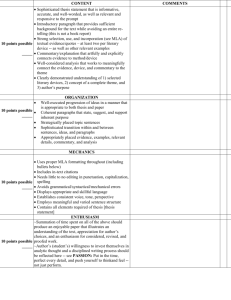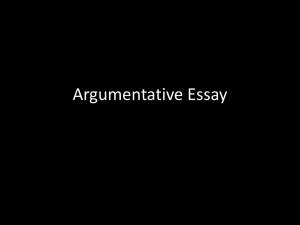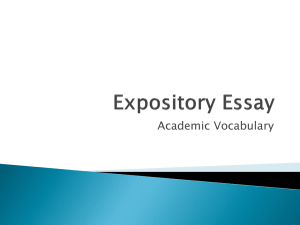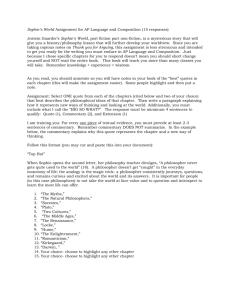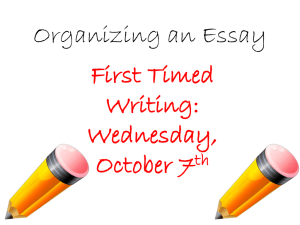The Elements of a Literary Analysis Essay
advertisement
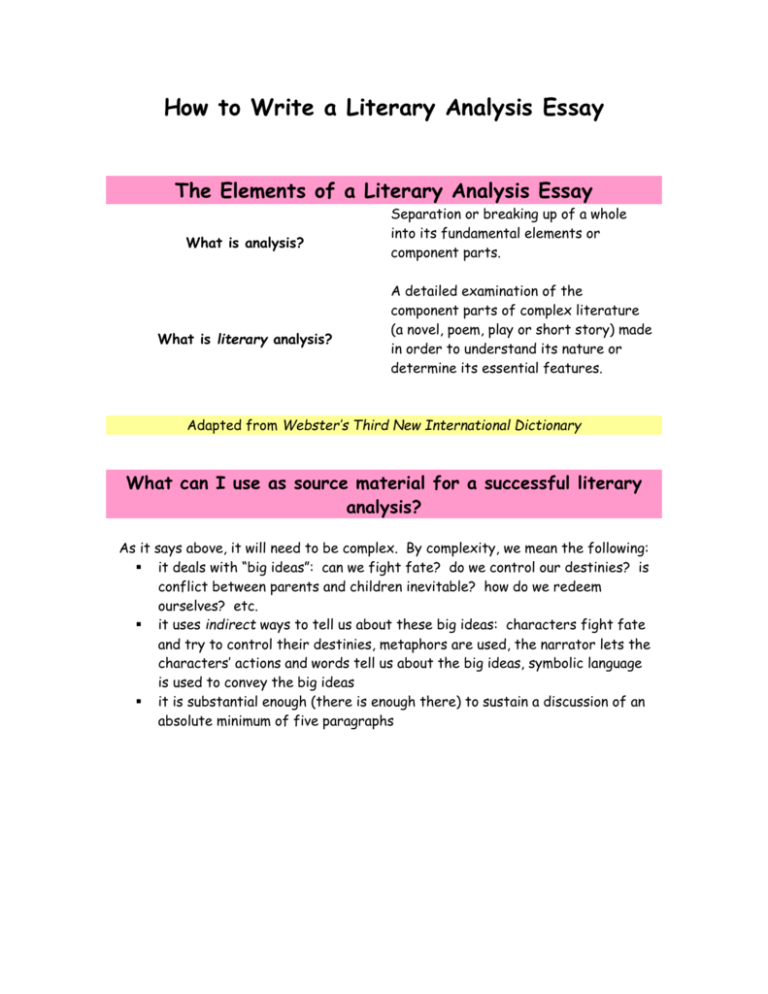
How to Write a Literary Analysis Essay The Elements of a Literary Analysis Essay What is analysis? What is literary analysis? Separation or breaking up of a whole into its fundamental elements or component parts. A detailed examination of the component parts of complex literature (a novel, poem, play or short story) made in order to understand its nature or determine its essential features. Adapted from Webster’s Third New International Dictionary What can I use as source material for a successful literary analysis? As it says above, it will need to be complex. By complexity, we mean the following: it deals with “big ideas”: can we fight fate? do we control our destinies? is conflict between parents and children inevitable? how do we redeem ourselves? etc. it uses indirect ways to tell us about these big ideas: characters fight fate and try to control their destinies, metaphors are used, the narrator lets the characters’ actions and words tell us about the big ideas, symbolic language is used to convey the big ideas it is substantial enough (there is enough there) to sustain a discussion of an absolute minimum of five paragraphs What are the different types of literary analysis and which one should I choose? Type Description Example Assignment Analyzing an Element of Literature In this type of analysis, the writer chooses one or more elements of literature and focuses on how well the author used the element(s) and for what purpose. Notice the focus of the analysis is very narrow. Discuss the author’s intent in using a particular element of literature and the effect of that element: characterization imagery figures of speech symbolism plotting/sequencing point of view Works well for almost any novel, short story, play, or poem. Thematic Analysis In this type of analysis, the writer focuses on analyzing the major theme(s) of a text and how the author crafted that theme through the elements of literature. Works well for novels and plays because there is more time to develop the theme Thesis: Smith’s use of symbols allows us to see Mr. X’s moral degradation more clearly as the story progresses. Discuss the theme of the story with supporting evidence from the text. Thesis: Oedipus Rex centers on the idea that we cannot fight our fate and that doing so brings disaster. This type of analysis involves a close reading of the text in order to analyze the author’s style. Style or Prose Analysis Works well for poems and for any piece of literature that has an unusual style or structure Discuss the author’s style and its effect through an analysis of: *diction *use and choice of details *point of view *organization (non-linear plotting) Thesis: Hemingway’s use of short, almost brutal, sentences aligns with the nature of his characters and contributes to the themes of his novels. This very sophisticated type of analysis involves critiquing a text using a well-known method of literary criticism. Critical Analysis Works well for any piece of literature or philosophy that comes from a readily identifiable author, era, and philosophical tradition. Works best when you can find a lot of autobiographical information on the author. Critique a text using one of the following critical theories: Historical Criticism (examining the work in light of the time in which it was written OR in light of current values and norms) Multicultural Criticism (examining what is says about the state of interaction between cultures) Feminist Critical Theory (examining what it says about the relationship between genders) Marxist Critical Theory (what it says about power relationships) Deconstructionism (examining how the writer creates meaning) Thesis: Using feminist critical theory to examine Hamlet’s relationship to Ophelia allows us to see her as a more rounded character. Writing Strategies for a Literary Analysis Essay Thematic Analysis 1. Read the question or essay prompt. Identify the theme you want to discuss 2. Develop a thesis statement that identifies the theme and says what the theme contributes to the novel 3. Find examples from the text to support your thesis. Write them down along with page or line numbers. 4. Develop the body paragraphs of your essay with supporting details and commentary for each paragraph. 5. Develop a conclusion that evaluates the success this piece of literature has in exploring this theme. Analyzing an Element of Literature 1. Read the question or essay prompt. Identify the elements you want to discuss 2. Develop a thesis statement that identifies the elements you plan to discuss and says what their inclusion brings to the story. 3. Support your thesis by discussing elements of literature (between 2 and 4) in the text. 4. Develop the body paragraphs of your essay with supporting details and commentary for each paragraph 5. Develop a conclusion that evaluates the contribution that these elements bring to this piece of work. Style or Prose Analysis 1. Read the question or essay prompt. Identify the stylistic element you want to analyze. 2. Develop a thesis statement that identifies and describes the stylistic element and explains how its use affects the work. 3. Find examples from the text that support your thesis. 4. Develop the body paragraphs of your essay with supporting details and commentary for each paragraph 5. Develop a conclusion that evaluates how these stylistic elements affect the work. Critical Analysis 1. Read the question or essay prompt. Determine which critical theory will best fit your text. 2. Critical theory analyzes a text looking for different traits or through different focal 3. 4. 6. 5. points. Determine what traits or which focus best suits the critical theory you will use to analyze the text. Now develop a thesis statement that identifies the critical theory to be applied and states what the use of this critical theory allows readers to see in this work. Find examples from the text that support your thesis. Develop the body paragraphs of your essay with supporting details and commentary for each paragraph Develop a conclusion that evaluates how these stylistic elements affect the work. The style in which literary analysis is written Literary analysis essays are a little different from other essays in a few key ways: Point of view Types of evidence The way the evidence is used Point of View in Literary Analysis A literary analysis is a formal academic essay in which the writer presents a thesis, or opinion on a subject. In such formal academic writing, the proper point of view for the essay is third person (using the pronouns he, she, it, they). It’s redundant to use first person (using the pronoun I) in an essay that requires a writer’s opinion. The audience already knows it is your opinion! INCORRECT: First Person I think that the death of Piggy in William Golding’s Lord of Flies symbolizes the death of civilization. CORRECT: Third Person The death of Piggy in William Golding’s Lord of the Flies symbolizes the death of civilization. Evidence & Citations Literary analysis essays rely on the inclusion of direct evidence from the text. You will need to quote extensively to be successful. Why use quotes? 1. They demonstrate you read the text closely. 2. They serve as concrete evidence to support a generalization (or opinion statement). 3. They provide a deeper level of detail and understanding. Where can evidence come from? What can I quote from? You can only use three things for a literary analysis essay: the text itself, criticism of the writer written by other writers or literary critics, and (in very small amounts) biographical or autobiographical works on the author. What can’t I use? Wikipedia, encyclopedias, other student essays, etc. How should I weave in quotes and commentary? The S-C-C-C Format 1. Set it up. Set up the context that the quote is from, so that the reader knows when and where the quote is from and who is doing the speaking/writing. This is a very useful format for citations 2. Citation. Write the quote out, in if you are not very familiar with quotation marks. citations and need to practice a tried 3. Commentary: Explain how the quote and true method. As writers become supports your topic/thesis. (Commenting experienced with citations, they can on the quote.) move away from this format and mix 4. Commentary: further commenting on elements up as they see fit. the quote EXAMPLE: In an effort to make Othello jealous, Iago uses reverse psychology when he warns Othello, “O Beware, my lord, of jealousy! /It is the green-eyed monster” The Embedded Citation This is useful when you would prefer to pick out very small phrases to prove your points. ( III.iii.180-181). The master of emotional manipulation, Iago controls Othello by warning him unnecessarily against jealousy, thus planting the seeds of jealousy in within Othello’s heart. It also gives Iago the opportunity to tell others that he warned Othello, thus absolving Iago of any responsibility. Write your own sentence beginning, include the quote, and write your own sentence ending. The quote flows into and out of the sentence. EXAMPLE: It is Othello’s “green-eyed monster” that is the ultimate cause of his destruction (III.iii.181). Some specifics about citing Citing Lines of Poetry 1. Cite verse (plays and poems) by divisions (act, scene, canto, book, part) and lines, using Arabic numerals for the various divisions. 2. Use periods to separate the various parts. 3. If you care citing lines only, use the word “line” or “lines” in your first reference and numbers only in parenthesis in the additional references. When she learns that Romeo is a Montague, Juliet exclaims, “ My only love, sprung from my only hate!/Too early seen unknown, and known too late” (1.5.138-139). Note: A diagonal “/” is used to show where each new line of verse begins.” Citing Verse Quotations Verse quotations of more than three lines should be indented 10 spaces and singlespaced, after double spacing away from the main body of the text. Each line of the poem or play begins a new line of the quotation. Do NOT run the lines together or separate them with diagonals. Diagonals are used to separate lines only when you are quoting within the main text of your paper. Put the line numbers in parenthesis after the punctuation mark in this case. Skip two spaces before you begin the citation. Example: Elizabeth Bishop’s poem “The Fish” contains layer upon layer of specific concrete details: He was speckled with barnacles, Five rosettes of lines And infested With tiny white sea lice, And underneath two or three Rags of green weed hung down. (16-21) Citing Novels or Books Citing from one text: 1. To cite other texts like stories and novels, list the page number in parenthesis after the work. 2. Include the word “Page” only the first time you reference the work. 3. After that, use simple page numbers (16-17). Example: In Cry, The Beloved Country, Alan Paton presents Steven Kumalo as “a man who lives in a world not made for him, whose own world is slipping away, dying, being destroyed, beyond recall” (Page 14). Citing more than one book by the same author: If you are planning on discussing more than one book by the same author, you will need to cite the title of the book every time, instead of the author’s name. The title of a book should be italicized, or underlined if you are hand writing a document. The author should be implied in the body of your text. Example: (Great Expectations, 14) (A Tale of Two Cities, 13) Citing books by different authors in the same paper: If you are planning on discussing more than one book by different authors, you will need to cite the author’s name every time. (Paton, 145) (Mathabane, 45-46) Really Long Citations When you are quoting prose more than four typed lines long, indent each line of the quote 10 spaces and single space it. In this case, you place the parenthetical citation outside the end of the punctuation mark of the quotation itself. Skip two spaces before you begin the citation. This is in the same basic style as quoting more than four lines of poetry above. How to Write Commentary Of all the skills students must learn in style analysis, writing commentary is considered the most difficult. Writing commentary means giving your own opinion and interpretation about something, which requires a higher level of thinking than most students are used to demonstrating. Using commentary makes an essay interesting to read and shows that you can analyze and evaluate information. When you write commentary, you are commenting on a point you have made. Synonyms for commentary: analysis interpretation insight evaluation explication discussion speculation There are two methods for developing commentary in a body paragraph: Method One: The SCCC format - for direct quotes 1. 2. 3. 4. Set-up the context of the quote Quote Commentary on quote Commentary on quote Method Two: Concrete Detail Format – for concrete details 1. Topic Sentence 2. Concrete Detail Sentence 3. Commentary about the concrete detail 4. Commentary about the concrete detail Source: Jane Schaeffer Publications, Style Analysi s (1998) The Basic Outline for a Literary Analysis 1. Hook (Catching the reader’s attention) 2. Context of the work (includes author, text title and any background info needed to understand the thesis) 3. Thesis Statement Introduction Body Paragraphs and their topics should be ordered in the same order that the topics were introduced in the introduction. Body A. Major Point #1 1. supporting evidence/commentary 2. supporting evidence/commentary 3. supporting evidence/commentary B. Major Point #2 1. supporting evidence/commentary 2. supporting evidence/commentary 3. supporting evidence/commentary C. Major Point #3 1. supporting evidence/commentary 2. supporting evidence/commentary 3. supporting evidence/commentary A minimum of two pieces of evidence per major point is required for proficiency. More is better!!! Conclusion Restate or reemphasize the thesis. Evaluate what the ideas contribute to the text, to any discussion of the big ideas it discussed, or to readers in general End with a final observation that leaves the reader thinking.

